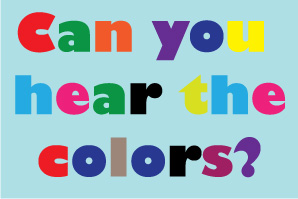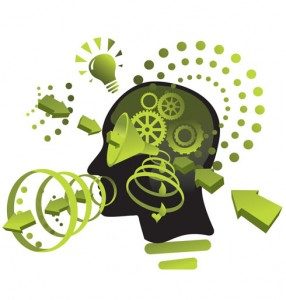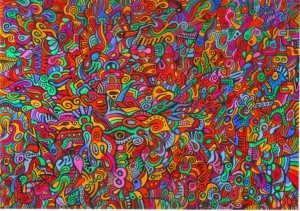 What colour is the sound of a dog barking? What does brown taste like? What does red paint sound like?
What colour is the sound of a dog barking? What does brown taste like? What does red paint sound like?
To many people the above questions may be nonsensical and confusing, but to a select few people they make perfect sense. That group of people are referred to as Synesthetes, or are afflicted by Synesthisia.
Synesthesia (from the Greek syn-, “together” and aesthesis, “perception”) is defined as a condition whereby sensory information is combined by the brain in unique ways.[1] Simply put, it is a unique condition wherein a person’s senses get scrambled. When they hear a sound, say the musical note C, they may also see the colour red. When they see something blue, they also taste, say, cheese. It can be a combining of any two or more senses.
“Most of us experience various pieces of sensory information as independent from each other, because our five senses enter our brain through different, independent sensory organs and travel along sensory pathways that are completely separate from one another. Our brains combine information from these sensory systems into a coherent package that we experience as the external world.”[2]
 However, there is a place in our brains where these signals come relatively close together, close enough to get jumbled in a small percentage of the population. That place is called the angular gyrus. This is a small part of the parietal lobe that lies near the superior edge of the temporal lobe; it is involved in a number of processes related to language, mathematics and cognition. Oddly enough, the angular gyrus is considered to be linked in some way to Out of Body Experiences (OBE’s), and has shown damage following Near Death Experiences (NDE’s).
However, there is a place in our brains where these signals come relatively close together, close enough to get jumbled in a small percentage of the population. That place is called the angular gyrus. This is a small part of the parietal lobe that lies near the superior edge of the temporal lobe; it is involved in a number of processes related to language, mathematics and cognition. Oddly enough, the angular gyrus is considered to be linked in some way to Out of Body Experiences (OBE’s), and has shown damage following Near Death Experiences (NDE’s).
It is believed that a malfunction of the angular gyrus is responsible for Synesthesia. Neurologist V.S. Ramachandran has proposed that Synesthesia results from “cross talk” between the different pathways that run through the angular gyrus.[3]
The most common form of Synesthesia, known as grapheme (color Synesthesia or color-graphemic Synesthesia), results in letters or numbers being perceived as inherently coloured. Ramachandran described a case of a colour-blind Synesthete who saw colours associated with numbers. Colours he normally couldn’t see were evoked by certain numbers. The colours were so alien to the Synesthete that he referred to them as “Martian Colors”.
There seems to be some scientific merit in the idea that Synesthesia is connected in some way to clairvoyance and premonitions, among other things. Neurologist Richard Cytowic found that 17 percent of Synesthetes have a high frequency of “unusual experiences”, and near-death researcher P.M.H. Atwater claimed to have psychic abilities and several interconnected senses following her NDE’s. She claimed to see music, hear numbers and smell colours. In addition, it seems that there may be link between autistic savants and Synesthesia.
Interestingly, psychics who claim also to be Synesthetes, also tend to be able to see auras, which, in these cases, are colours that are believed to be connected to personality types.
 True Synesthetes tend also to have incredible memory abilities, or fund knowledge. They tend to score high on traditional IQ tests. Indeed, a Synesthete performer known by the pseudonym S, made a living by displaying his ability to remember series of numbers and words and he also claimed to have some psychokinetic ability as well.[4] Unfortunately his abilities out ran his ability to cope, his memory was far more than just eidetic.
True Synesthetes tend also to have incredible memory abilities, or fund knowledge. They tend to score high on traditional IQ tests. Indeed, a Synesthete performer known by the pseudonym S, made a living by displaying his ability to remember series of numbers and words and he also claimed to have some psychokinetic ability as well.[4] Unfortunately his abilities out ran his ability to cope, his memory was far more than just eidetic.
Though Synesthesia isn’t all red roses and candy floss, often Synesthetes tend to have brain hemisphere damage and hemispheric dominance issues, they have difficulty deciphering left from right, and often have personality disorders.
The first brain imaging study of Synesthesia was done by Cytowic more than 20 years ago. His subject had an unusual form of Synesthesia; he claimed that he felt spheres, cones, columns and other shapes press against his skin whenever he smelled different fragrances.
While cross-sensory metaphors (e.g., “loud shirt,” “bitter wind” or “prickly laugh”) are sometimes described as “Synesthetic”, true neurological synesthesia is involuntary. It is estimated that Synesthesia could possibly be as prevalent as 1 in 23 persons across its range of variants. Synesthesia runs strongly in families, but the precise mode of inheritance has yet to be ascertained. Synesthesia is also sometimes reported by individuals under the influence of psychedelic drugs, after a stroke, during a temporal lobe epilepsy seizure, or as a result of blindness or deafness.
Any way you slice it, Synesthesia is one of the stranger areas of psychic research, it clearly has ties to neurological processes that are both mysterious and elusive. Typical Synesthetes live normal lives and are contributing members of society, but whatever the tastes of the day may be, our world remains as colourful today as ever, and I can’t help but draw correlations between the effects of Synesthesia and the conclusions I have made in my previous article titled PSI…Where Does It All Come From.
[1] Diane Hannacy Powell, The Esp Enigma, The Scientific Case for Psychic Phenomenon pp.148
[2] Diane Hannacy Powell, The Esp Enigma, The Scientific Case for Psychic Phenomenon pp.148
[3] V.S Ramachandran and E.M Hubbard, “Hearing colors and tasting shapes,” Scientific American.com, April 13, 2003.
[4] A.R Luria and Jerome Bruner, The Mind of a Mnemonist: A Little Book About A Vast Memory, Harvard University Press.
